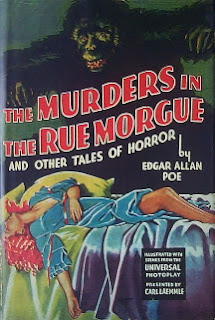Murders in the Rue
Morgue
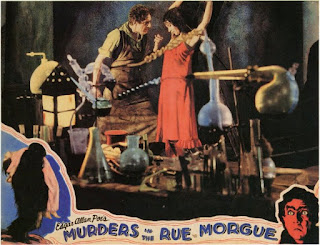
Director: Robert
Florey
Year: 1931
Rating: 7.0
Though
this horror film was made smack in the middle of Universal's classic run
of that genre, it isn't nearly as well known as its neighbors Dracula, The
Mummy, The Invisible Man and Frankenstein. In fact, the director of this
film, Robert Florey, had initially been slated to direct Frankenstein and
had begun the groundwork before he was taken off and the job given to James
Whale. So Florey was handed this film as compensation along with Bela Lugosi.
It is in some ways brilliant and in other ways quite awful.
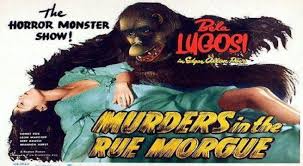
Even for its time - 1932 - it feels antiquated,
stilted, stogy and at 60 minutes rather rushed. It has all the trappings
of a silent horror film with its overly expressive acting and make-up, the
strongly influenced expressionistic sets, the myriad of close-ups of extras
and lovely use of shadows and design. It should have been a silent film because
the dialogue badly delivered is at times painful, especially the romantic
scenes "You are like a yellow star in the morning" and Lugosi ranting on
about evolution. This could have been a great silent film.
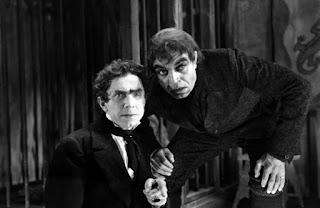
But the sets, designs and cinematography
make this more than watchable - it is at times a real pleasure. The creation
of Paris in the 1840's is weird and wonderful with background paintings of
the city that are abstract and delirious. Houses seem to tilt. Streets seem
to reek of evil. Fog is like a plague at night. The one set piece in which
Lugosi and his Igoresque servant have kidnapped a street walker (Arlene Francis
long before she was a regular panelist on What's My Line) and tied her to
a crucifix in his laboratory as he experiments on her is stunning and especially
how he gets rid of her. Even today it somehow feels sacrilegious.
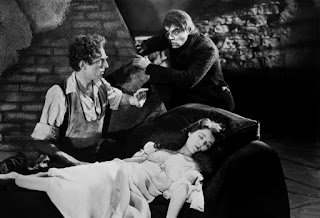
Lugosi's character (Dr. Mirakle) who seems
to have mutated caterpillars as eyebrows and a powdered white ghastly pallor
is of the opinion that man was evolved from the ape. And he has an ape that
he names Eric and that he can command. In order to prove his crazy theory
he uses the newest scientific methods - kidnapping women and injecting them
with gorilla blood to see if it meshes. When it doesn't and they die - into
the Seine they go. An amateur detective, Pierre Dupin, notices all these
dead woman showing up at the morgue and investigates. Dupin is played by
Leon Waycoff who you are not likely to know but you may recognize his later
stage name of Leon Ames who was in a ton of films in the 30's and 40's, generally
as a slimy businessman - though his most famous role was probably as the
kind father in Meet Me in St. Louis. His girlfriend who ends up in a wonderful
roof top King Kong like scene at the end is Sidney Fox. Very cute and demur,
she was to commit suicide ten years later.
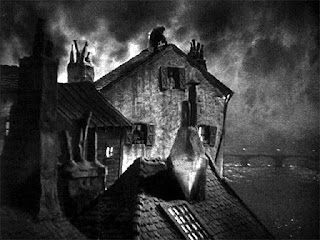
Now if you go off to read the story this
was "based" on, the Murders in the Rue Morgue written by Edgar Allan Poe
in 1841, you may be disappointed. Like pretty much every film I have seen
based on a Poe story or poem it has only a slight resemblance. One of the
writers of this was none other than John Huston who said he wanted to inject
more Poe like language into the script but it all got cut out by Florey.
As does most of the Poe story. One problem in adapting Poe to film is that
he wrote short stories and poetry - The Raven, The Haunted Palace, The City
in the Sea - and trying to make a full length film out of them was a challenge
- though often they took the title (public domain) and nothing else.
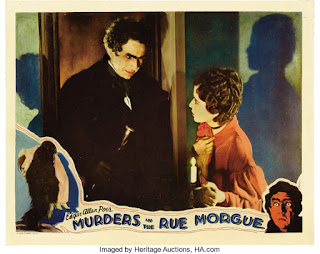
But Poe's Murders in the Rue Morgue is a
landmark short story. It basically created the detective novel and many of
its characteristics for years to come. Auguste Dupin is nothing like our
romantic action hero of this film. He is an aristocrat fallen on hard times
and in three Poe stories (the other two being The Purloined Letter and The
Mystery of Marie Roget) he solves cases simply through observation and thinking.
The stories are told through a nameless narrator, Dupin is an eccentric easily
bored, he makes fools of the police, the reader is given the same clues as
Dupin and in Morgue it is a Locked Room Mystery - all these characteristics
were used by many later mystery writers from Doyle to Christie to John Dickson
Carr. At the same time as ground breaking as the story was - and it is such
a shame he didn't write many more Dupin mysteries - it is rather silly. The
guilty party is an orangutan - which is actually one of the few bits that
this film keeps!







